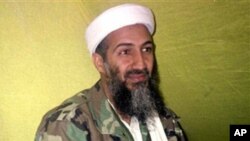A brief look at how Osama bin Laden terrorized the Western world with a series of deadly attacks after emerging from the ranks of a wealthy Saudi Arabian family to create and lead a global terrorist network:
1988: After aiding mujahideen fighters against the Soviet occupation in Afghanistan, Osama bin Laden establishes al-Qaida, which means "the base" in Arabic.
1990-1991: The arrival of U.S. forces in Saudi Arabia to help defend Kuwait, invaded by Iraq, angers bin Laden. He clashes with Saudi authorities and is forced to leave for Sudan, where he sets up a base of operations for al-Qaida.
1992: A bomb explodes at a hotel in Yemen, shortly after a group of U.S. soldiers leave. Intelligence officials later determine this was bin Laden's first attack.
1993: Terrorists linked to al-Qaida explode a truck bomb in a parking garage underneath the World Trade Center in New York City. The blast kills six people, but fails to bring down the towers.
1996: A truck bomb destroys Khobar Towers, a U.S. military residence in Saudi Arabia, killing 19 American soldiers.
1998:
February: Bin Laden declares to the world that it is the duty of every Muslim to "kill Americans wherever they are found."
August: Bombs explode simultaneously at the U.S. Embassies in Kenya and Tanzania, killing 224 people and wounding some 4,500 others. Then-U.S. President Bill Clinton declares bin Laden "Public Enemy Number One."
2000: Suicide attackers ram a boat full of explosives into the hull of the USS Cole in Yemen, killing 17 U.S. sailors and wounding more than 30 others.
2001:
September 11: Al-Qaida hijackers fly two passenger planes into the World Trade Center's twin towers in New York City and a third plane into the U.S. military headquarters outside Washington. A fourth hijacked plane meant for another target in the U.S. capital crashes into a field in Pennsylvania. In total, some 3,000 men, women and children die in the attacks. Bin Laden later releases a tape in which he takes responsibility.
December: Passengers on a transatlantic flight from Paris to Miami prevent bin Laden-sympathizer Richard Reid from detonating explosives concealed in his shoes.
2002: Two bombs explode in a crowded nightclub area on the Indonesian resort island of Bali, killing 202 people, including 28 British citizens. Authorities blame an al-Qaida-linked group for the attack.
2003: 9/11 plotter Khalid Sheikh Mohammed is captured in Pakistan. He reportedly gives interrogators information on bin Laden couriers.
2004: Bombs explode on commuter trains in the Spanish capital, Madrid, killing at least 190 people. In a new tape attributed to bin Laden, the al-Qaida leader reportedly offers a truce to European countries that do not interfere in the affairs of Muslims.
2005:
Four explosions hit London's transit system, killing more than 35 people and wounding at least 700 others.
Al-Qaida's number 3, Abu Faraj al-Libbi is arrested by Pakistani special forces and turned over to the CIA.
2006: A U.S. air strike kills one of bin Laden's top commanders, al-Qaida's leader in Iraq, Abu Musab al-Zarqawi.
2007: U.S. officials learn the identity of one of bin Laden's courier's who will eventually lead them to him.
2010: U.S. intelligence officials identify the courier's residence in Abbottabad, Pakistan.
September 2010: President Obama is informed about the residence and told that a "high value target" is living there.
March 2011: President Obama begins meetings on the situation.
April 29, 2011: President Obama authorizes special forces to proceed.
May 1, 2011: President Obama tells the world that Osama bin Laden has been killed by U.S. special forces following a 40-minute firefight at his hideout in Abbottabad, Pakistan.
















